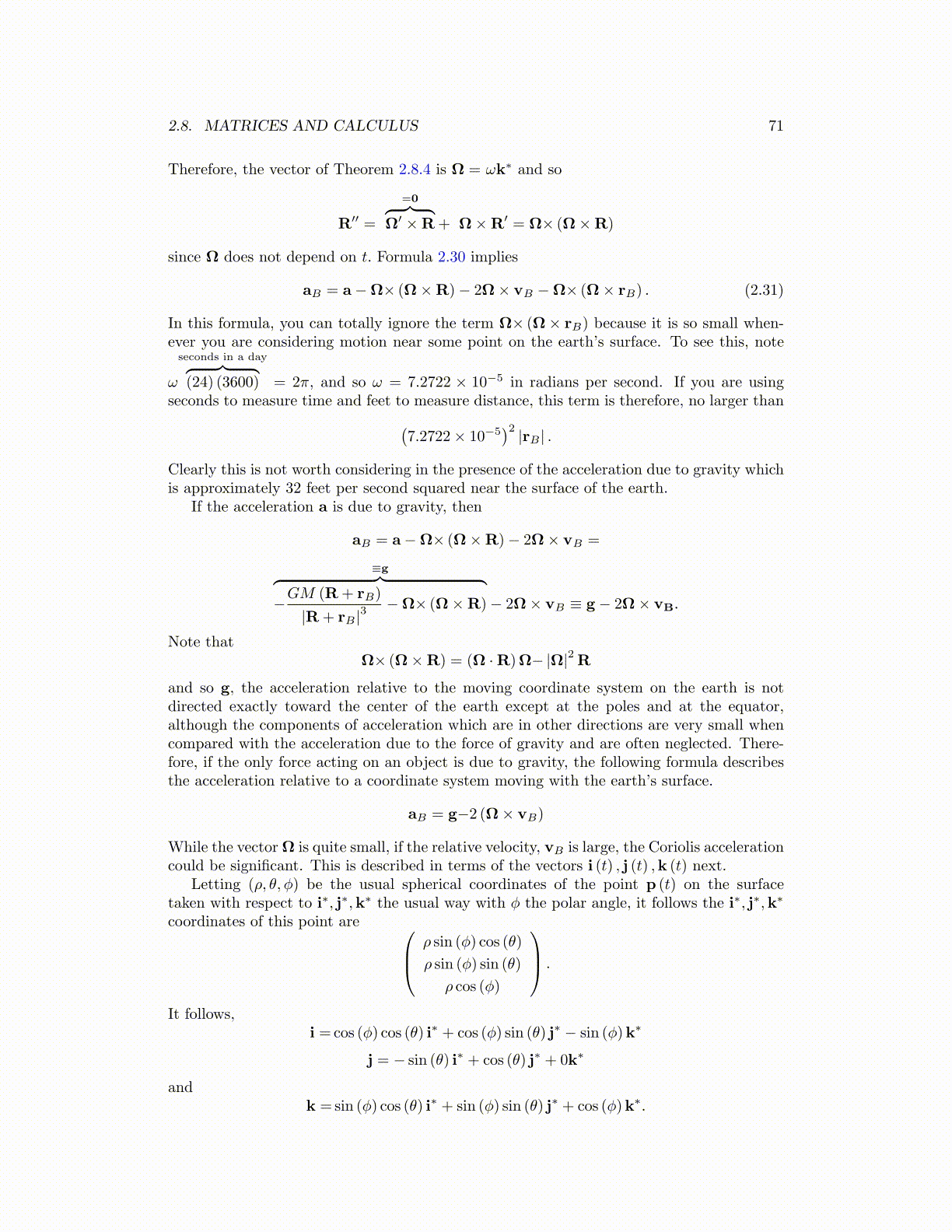
2.8. MATRICES AND CALCULUS 71
Therefore, the vector of Theorem 2.8.4 is Ω = ωk∗ and so
R′′ =
=0︷ ︸︸ ︷Ω′ ×R+ Ω×R′ = Ω× (Ω×R)
since Ω does not depend on t. Formula 2.30 implies
aB = a−Ω× (Ω×R)− 2Ω× vB −Ω× (Ω× rB) . (2.31)
In this formula, you can totally ignore the term Ω× (Ω× rB) because it is so small when-ever you are considering motion near some point on the earth’s surface. To see this, note
ω
seconds in a day︷ ︸︸ ︷(24) (3600) = 2π, and so ω = 7.2722 × 10−5 in radians per second. If you are using
seconds to measure time and feet to measure distance, this term is therefore, no larger than(7.2722× 10−5
)2 |rB | .Clearly this is not worth considering in the presence of the acceleration due to gravity whichis approximately 32 feet per second squared near the surface of the earth.
If the acceleration a is due to gravity, then
aB = a−Ω× (Ω×R)− 2Ω× vB =
≡g︷ ︸︸ ︷−GM (R+ rB)
|R+ rB |3−Ω× (Ω×R)− 2Ω× vB ≡ g − 2Ω× vB.
Note thatΩ× (Ω×R) = (Ω ·R)Ω− |Ω|2 R
and so g, the acceleration relative to the moving coordinate system on the earth is notdirected exactly toward the center of the earth except at the poles and at the equator,although the components of acceleration which are in other directions are very small whencompared with the acceleration due to the force of gravity and are often neglected. There-fore, if the only force acting on an object is due to gravity, the following formula describesthe acceleration relative to a coordinate system moving with the earth’s surface.
aB = g−2 (Ω× vB)
While the vectorΩ is quite small, if the relative velocity, vB is large, the Coriolis accelerationcould be significant. This is described in terms of the vectors i (t) , j (t) ,k (t) next.
Letting (ρ, θ, ϕ) be the usual spherical coordinates of the point p (t) on the surfacetaken with respect to i∗, j∗,k∗ the usual way with ϕ the polar angle, it follows the i∗, j∗,k∗
coordinates of this point are ρ sin (ϕ) cos (θ)
ρ sin (ϕ) sin (θ)
ρ cos (ϕ)
.
It follows,i =cos (ϕ) cos (θ) i∗ + cos (ϕ) sin (θ) j∗ − sin (ϕ)k∗
j = − sin (θ) i∗ + cos (θ) j∗ + 0k∗
andk =sin (ϕ) cos (θ) i∗ + sin (ϕ) sin (θ) j∗ + cos (ϕ)k∗.